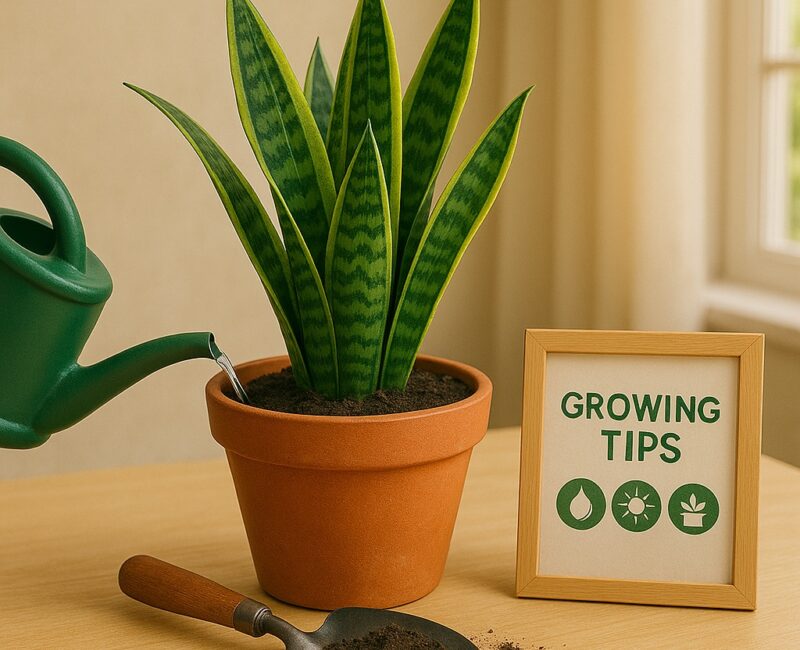Snake plants, known for their striking appearance and ease of care, have become one of the most popular choices for both new and experienced plant lovers. With their upright, sword-like leaves and reputation for cleansing the air, these hardy houseplants thrive on neglect and simplicity. Understanding how to properly care for your snake plant ensures it not only survives but looks its best year-round.
Understanding Snake Plant Basics
Originating from the dry, rocky soils of West Africa, the snake plant (Sansevieria) adapts well to indoor life. These plants are built to survive tough environments, making them ideal for people who want beauty without the fuss.
Plant Description and Benefits
Snake plants have stiff, architectural leaves that point skyward, often with lovely variegated patterns. Their ability to handle irregular watering and low light means they forgive most beginner mistakes.
Not only are snake plants visually appealing, but they’re proven to clean indoor air by filtering toxins like formaldehyde and benzene. Studies suggest you’d need several for significant air cleaning, but every bit helps. For more on the air-purifying qualities of this plant, see how snake plants help with air purification and sleep quality at Bloombox Club.
Popular Varieties
Snake plants come in various types. The ‘Laurentii’ stands out with creamy yellow leaf edges, the ‘Zeylanica’ sports deep green horizontal stripes, and the ‘Moonshine’ dazzles with its silver-green leaves. Each brings its own color and style, yet all share the same straightforward care needs.
| Variety | Leaf Color & Features | Ideal Setting |
|---|---|---|
| Laurentii | Green with gold margins | Statement corners, offices |
| Zeylanica | Wavy horizontal green stripes | Bedrooms, shaded spots |
| Moonshine | Pale silver-green, upright | Modern or minimalist décor |
Watering and Soil Guidelines
Snake plants are succulents at heart. Their biggest enemy? Too much water.
How Often to Water
In the growing seasons (spring and summer), water your snake plant every 2 to 4 weeks. Wait until the top two inches of soil are dry. In cooler months, extend the gap—even monthly is fine. Overwatering leads to soggy, yellow leaves and an unpleasant smell. Signs that your snake plant needs water include drooping leaves or soil pulling away from the pot’s sides.
A deep soak and drain method works best. Let water run through until it drains completely, ensuring no excess sits in the pot. Learn about watering and the allergy-reducing powers of snake plants at Bloomscape.
Soil Mix Recommendations
Choose a well-draining soil, like a succulent or cactus mix. You can add perlite or coarse sand for extra drainage. Avoid compact garden soil, which traps moisture. The right soil keeps roots healthy and prevents rot. For more practical tips, see this guide to caring for snake plants at A Beautiful Mess.
| Soil Component | Benefit |
|---|---|
| Cactus mix | Fast drainage, light texture |
| Perlite | Aerates, reduces compaction |
| Sand | Prevents excess moisture |
Always pick a pot with a drainage hole.
Light, Temperature, and Growth Tips
Most people worry if their house is bright enough for indoor plants. The snake plant’s tough nature means it’s likely to thrive wherever you place it, as long as a few basics are met.
Ideal Light Conditions
The sweet spot for snake plants is bright, indirect sunlight. They tolerate low light—perfect for offices or bedrooms with small windows. Direct sunlight, especially for extended hours, can scorch leaves and make patterns fade. Growing in lower light is possible, though growth will slow.
For extra insight into snake plant lighting, explore the detailed care guide at Leon & George.
Temperature and Humidity
Snake plants love warmth. Ideal indoor temperatures range from 60°F to 85°F (16°C to 29°C). Avoid placing them near cold drafty windows in winter. Average home humidity works well; there’s no need for a humidifier. Sudden cold or frost can cause leaf damage, so if your plant spends time outside in summer, remember to bring it in before temperatures dip.
Propagation Methods
Expanding your collection is simple. Snake plants grow from rhizomes (underground stems) and cut leaves.
Division is easiest. When repotting, pull the plant apart at the root ball. Each clump with roots can be potted separately.
Leaf cuttings also work. Cut a healthy leaf into four-inch sections. Let them dry for a day or two, then plant the cut tips in moist, well-draining soil. Place in bright, indirect light and water sparingly until new roots form (usually within weeks).
Timing matters less since the plant is adaptable, but you’ll see quicker results in spring or summer.
Conclusion
Snake plants prove that easy care can look beautiful. Water sparingly, use airy soil, and offer bright, indirect light for best growth. Avoid drafts and let soil dry between waterings—these simple steps help your snake plant thrive.
With so many eye-catching varieties, there’s a perfect choice for any room or style. Watch for signs of overwatering or stress, and try propagating if you want more plants to fill your home with clean air and greenery. For even more expert care guides, you can check resources like The Spruce’s Snake Plant Guide.
Invest a little consistency and enjoy a plant that makes every space fresh, stylish, and alive.





